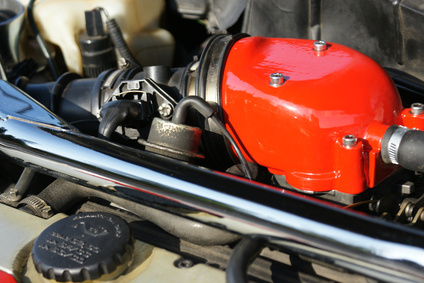
In the early 1970s, automobile manufacturers began equipping their vehicles with EGR (exhaust gas recirculation) valves to reduce the levels of pollutants created by their vehicles. At high temperatures, oxygen and nitrogen combine to form nitrogen oxide, which is considered one of the main components of smog. EGR valves help to reduce the amount of nitrogen oxide produced by automobile engines by lowering the temperature of the combustion process in an engine.
Nitrogen oxide is a noxious gas and is one of the main components found in smog. It is produced during the combustion process in an automobile when temperatures in the combustion chamber exceed 2,500 degrees.The EGR valve works to lower the combustion temperatures in an engine by introducing a controlled amount of exhaust gases into the engine cylinders. These exhaust gases cannot be burned again and merge with the fuel and air mixture that enters into a cylinder, which chemically lowers the temperature at which the fuel and air mixture burns, reducing the production of nitrogen oxides.
The EGR valve has an inlet tube that is connected to the engine's exhaust system and an outlet tube that is connected to the intake manifold. The main body of the unit contains a valve which opens under certain conditions to allow a certain amount of exhaust gas into the intake manifold, where it then mixes with the fuel and air mixture and cools the combustion process.
EGR valves on older vehicles manufactured before 1981 are operated according to the amount of vacuum created by the engine under different operating conditions. These units have a vacuum hose attached to them which connects to the intake manifold and provides the ported vacuum necessary to operate the valve. As the throttle is opened more vacuum is created, which causes the valve to open and introduce exhaust gases into the intake manifold. These early EGR systems also used a thermal switch which prevented the vacuum from operating the EGR valve until the engine reached normal operating temperature.
Newer vehicles manufactured after 1981 use vacuum and electronic signals to control the operation of the EGR valve. The EGR valve is connected to a vacuum source from the engine and also has one or more wires connecting it to the vehicle's computer. The computer uses sensors to monitor the operation of the engine and sends signals to solenoids within the EGR valve to more precisely control the valve's operation than vacuum operation alone can. This allows the EGR valve to operate much more efficiently and further reduce the production of nitrogen oxides.
When EGR valves fail, the system is unable to properly introduce exhaust gases into the fuel and air mixture, which causes the temperature within the combustion chambers to increase. This temperature increase can cause pre-ignition, knocking and pinging, and over-production of nitrogen oxide. To prevent this, modern vehicles use computer controls which note when the EGR valve is no longer adding exhaust gases to the fuel and air mixtures. The computer then reduces the amount of ignition advance, which in turn slows down the combustion process, but at the cost of reducing performance and fuel mileage. When the EGR valve fails, a code is set in the vehicle's computer, which causes the check engine light to come on. This code also allows automobile technicians to quickly determine the cause of the problem.